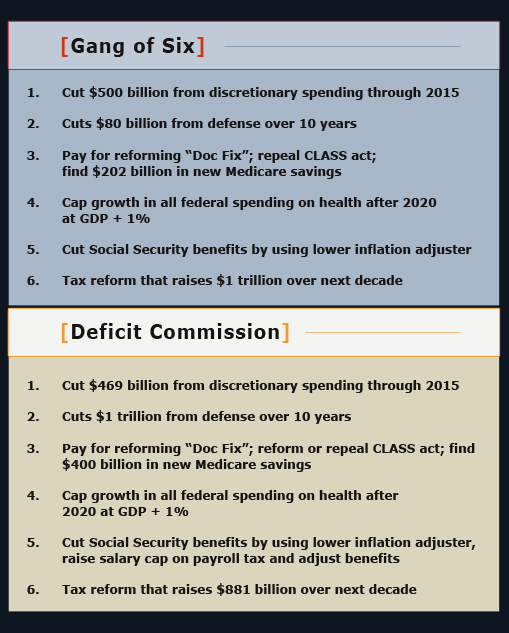The hastily drawn “Gang of Six” plan for reducing the deficit by $3.7 trillion over the coming decade targets many of the same sacred cows that the Bowles-Simpson deficit commission went after last December, including entitlement cuts and tax increases.
The proposal, drafted by six Republican and Democratic senators and quickly endorsed by President Obama on Tuesday, has received a generally positive reception in the Senate but a much cooler response in the GOP-controlled House.
The six Senate authors of the plan – Democrats Kent Conrad of North Dakota, Mark Warner of Virginia, and Richard Durbin of Illinois, and Republicans Saxby Chambliss of Georgia, Mike Crapo of Idaho and Tom Colburn of Oklahoma – borrowed heavily from the recommendations of the presidential deficit commission, although the overall deficit-reduction would fall short of the $4 trillion sought by Bowles-Simpson.
“What we’ve got to realize is that we’re 13 days away from a default,” Warner told MSNBC. “We’ve got to be responsible to get something done, and if we can build some of our process into the debt ceiling, if we can make sure this is at least the starting point for the conversation” then Congress and the White House can make some progress. “Remember, it’s got revenue, it’s got an approach that says defense spending has to take its hit as well as domestic spending….Warner said.
Republicans ideologically opposed to any increase in taxes, such as House Majority Leader Eric Cantor of Virginia and freshmen Republicans, are almost sure to object to the outline’s call for comprehensive tax reform that would raise $1 trillion in new revenue over the next decade, more than the $785 billion in new revenues called for by the Simpson Bowles commission.
Taxes would rise under the proposal in two ways. Changing the Social Security cost-of-living adjustment would not only lower benefit payouts by about 7 percent on average over the next decade, it would also change a number of government formulas for adjusting tax brackets and deductions, which would have the net effect of raising taxes by nearly $100 billion.
But the far larger increase would come from reform that would lower rates while lowering the amount that can be deducted from total income for charitable giving, home mortgage interest, and retirement savings. The proposal also calls for limiting “health” deductions, which means more families would see their health care benefits taxed than are currently expected under health care reform.
The allure of lower rates is likely to give way to widespread Republican opposition to the higher taxes on tens of millions of middle-class households who would be hit by a “reform” that limits many commonly taken tax deductions.
Senior groups that are intent on fighting any cuts in entitlement programs are sure to raise their voices against a move to whittle away at future Social Security payments by reducing the cost-of-living adjustment, especially if it is attempted without ensuring Social Security’s long-term financial viability. The plan reserves its biggest cuts -- $500 billion through 2015 --for domestic discretionary programs like cleaning up the environment, safer food, and housing. That is more than the $469 billion in discretionary spending cuts proposed by the presidential commission.
Health care providers and patients in the Medicare and Medicaid programs may not find much to like in the plan. It calls for slightly lower future payments for physicians through “reform” of the reimbursement system; elimination of the long-term-care-insurance program created under the Affordable Care Act; and institutes another round of cuts to Medicare – on top of the nearly $500 billion already scheduled under reform.
About the only group that might heave a sigh of relief are diehard military spending hawks. Though crucial details are missing in the five-page plan, the Gang of Six proposal calls for only $80 billion in cuts to military budgets over the next decade. That’s $320 billion less than the President offered last April, and a tiny fraction of the $1 trillion in military cuts called for by Bowles-Simpson.
“$80 billion over 10 years is nothing,” said Todd Harrison, a senior fellow at the Center for Strategic and Budgetary Assessments, a defense think tank. “The defense budget could continue growing, but at a slightly lower rate.”
The Gang of Six plan for Medicare starts by digging a deeper hole. It would permanently fix the so-called sustainable growth rate formula for physician pay, which gets temporarily lifted every year. A permanent “doc fix” is now slated to cost $298 billion over the next decade.
To raise that money as well as another $202 billion (or is it $85 billion? The hastily slapped together plan uses both numbers, inexplicably separated by a slash), the plan calls for new “health savings” that would “maintain the essential health-care services that the poor and elderly rely upon.” Whether the plan needs to come up with $202 billion or $85 billion on top of the $298 billion, it will be hard for Medicare and Medicaid to achieve those goals without cutting into core programs, advocates say.
“Virtually all of the items would elicit some degree of unhappiness from providers, states or beneficiaries,” said Paul Van de Water, a health-care-policy analyst for the Center for Budget and Policy Priorities. “It doesn’t mean that it’s not doable. It’s just that it’s a challenge.”
Significantly, the plan also calls for holding all federal health care spending--which presumably would include veterans care and federal employee benefits as well as the two big entitlement programs--to a formula growth rate equal to the rate of growth of the national economy plus one percent. If that sounds familiar, it should since it’s the same formula contained in the health-care-reform bill the President signed into law last year. That formula will be enforced by an Independent Payments Advisory Board that has drawn heated opposition from Republicans as an “unelected rationing board.”
Recognizing their plan makes only a $500 billion down payment on its headline $3.7 trillion in deficit reduction, the Gang of Six focuses almost as much attention on budget process as it does on specific calls for cuts or tax changes. The plan says that if any committee fails to report the entitlement cuts needed to meet the savings projections in the plan, an expedited bill will immediately move to the Senate floor that would “impose across-the-board cuts to programs in that committee’s jurisdiction as necessary to achieve the required savings.”






